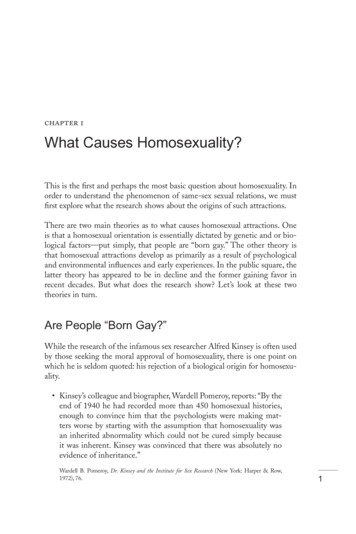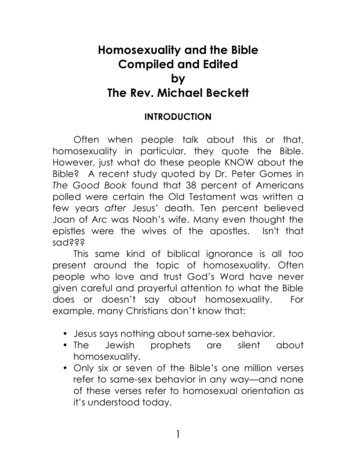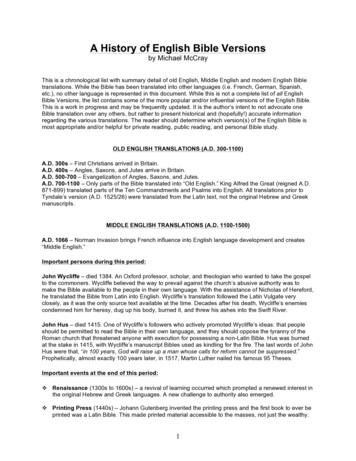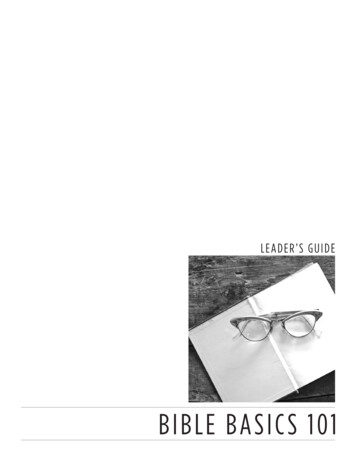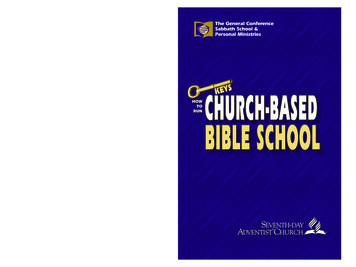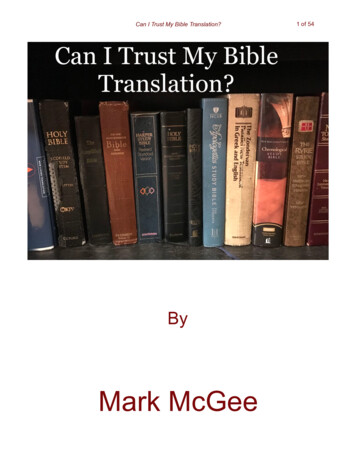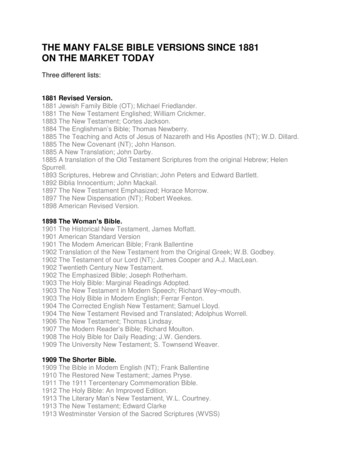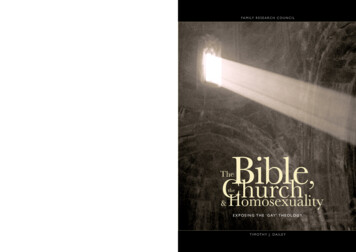
Transcription
FA M I LY R E S E A R C H C O U N C I Llthough the leading Christian churches in the UnitedStates continue to view homosexual behavior asoutside the realm of appropriate Christian conduct,revisionist scholars within their respective communions continue a campaign to re-interpret or ignore biblical teachingregarding homosexuality. Exposing the faulty reasoning behindthe gay hermeneutic, The Bible, The Church, and Homosexualitydemonstrates how homosexuality is unambiguously foundwanting by Scripture and tradition.is Senior Fellow in the Center for Marriageand Family Studies at the Family Research Council. His studyis based upon his doctoral dissertation, completed at MarquetteUniversity.T I M OT H Y J . DA I L E YBible,ChurchThethe&HomosexualityE X P O S I N G T H E ‘ G AY ’ T H E O L O G YBL04F01family research counciltony perkins, president801 g street nwwashington, dc 20001www.frc.orgT I M OT H Y J . DA I L E Y
Bible,ChurchThethe&HomosexualityE X P O S I N G T H E ‘ G AY ’ T H E O L O G Y
The Bible, the Church, and Homosexuality: Exposing the ‘Gay’ Theologyby Timothy J. Dailey 2004 by the Family Research CouncilAll rights reserved.Scripture passages identified as NRSV are taken from the New Revised Standard Version of the Bible, copyright 1989 by the Division of Christian Education of the National Council of the Churches of Christ in the USA.Used by permission. All rights reserved. Scripture passages identified as NIV are taken from the Holy Bible: NewInternational Version . NIV . Copyright 1973, 1978, 1984 by International Bible Society. Used by permissionof Zondervan Publishing House. The “NIV” and “New International Version” trademarks are registered in theUnited States Patent and Trademark Office by the International Bible Society.Family Research Council801 G Street, N.W.Washington, DC 20001Printed in the United States of America.Design by Amanda SwinghamerCover photo by Mark Haskew
ContentsIntroductionvI N T E R P R E T I N G T H E O L D T E S TA M E N T1Genesis 19: The Sodom StoryJudges 19: The Outrage of GibeahLeviticus 18 and 20: The Mosaic LawDeuteronomy 23: Cultic Prostitution1 Samuel 18 and 2 Samuel 1: David and Jonathan13456I N T E R P R E T I N G T H E N E W T E S TA M E N T9Romans 1: Unnatural Sexual Relations1 Corinthians 6: Male Prostitutes and Sodomites910W H Y T H E H I S TO R I C A L LY C O N D I T I O N E D A R G U M E N T F A I L S15Confusing the Moral and Ceremonial LawDid St. Paul Understand ‘Sexual Orientation’?1517T H E A P P E A L TO T H E O L O G I C A L T H E M E S21The Importance of Objective StandardsGenesis 1: The Created OrderJesus and HomosexualityThe Theological Symbolism of Marriage22222424T H E W I T N E S S O F H I S TO RY27Boswell’s Argument ExposedThe Witness of the Early ChurchOther Historical TestimonyThe Wisdom of the Judeo-Christian Ethic27303031Appendix: Where the Churches Stand on HomosexualityNotes3339
IntroductionThe assault on marriage and the family in the United States has been carriedon in a number of fronts: the courts, the world of academia, and the Hollywoodentertainment industry. Yet the weakening of the institution of marriage by the pushto normalize adultery, divorce, and homosexuality has also proceeded in a culturalsphere where many Americans would least expect it—in the nation’s religiousinstitutions. While the Jewish and Catholic traditions have witnessed their share ofthe struggle, recent debates over homosexuality in the major Protestant communionsmay represent the most contentious arena in which the struggle over marriage hasbeen waged.While the Family Research Council exists to engage the world of public policyand uphold marriage in the civil realm of culture, it is aware of the strugglesfor marriage and the family in religious institutions that claim the allegiance ofmillions of Americans. Although the Family Research Council does not seekto thrust itself into ecclesiastical or theological controversies, it recognizes thatthe controversies over homosexuality in the churches reflect deeper struggles inAmerican society. The effort to persuade theologians, clergy, and ecclesiasticalgoverning bodies of the moral legitimacy of homosexual conduct has notbeen carried out in a vacuum. The forces against marriage know that, if theysucceed in this realm, they will have achieved a cultural triumph that is morestrategic than any political or legal battle they might win in the civil courts or inWashington, D.C.At least for now, these efforts to “revise” the historic teaching of the churcheshave not succeeded. None of the eight largest Christian churches in the UnitedStates has given her blessing to homosexuality. Only the United Church of Christ,which defers the issue to regional associations and local congregations, and theEpiscopal Church, whose position is ambiguous, appear to be faltering. As outlinedin the appendix, most of the major denominations have remained resilient undertremendous pressure; they have explicitly judged homosexual behavior as outside therealm of appropriate Christian conduct. Nevertheless, the battles continue, as thosewho favor homosexuality seem unwilling to concede any ground, at times defyingbiblical, theological, and constitutional standards of their respective denominations.v
THE BIBLE, THE CHURCH, AND HOMOSEXUALITYviThis booklet therefore aims to encourage Americans who want to respondintelligently to the push to sanction homosexuality within their churches. To do that,conservatives need to understand both the strategy and argument of those who seekto revise or redefine historic Christian teaching regarding homosexuality. Called“revisionists,” these scholar-activists advance the notion that homosexuality is anissue over which people of good will can differ. Or they claim that there is no “clearanswer” to the issue. Then they recommend, under the rubric of “fairness,” thatchurches appoint task forces to study the issue.Once the “studies” begin, the revisionists claim that biblical passages thatproscribe homosexual acts do not actually refer to homosexuality; they at most onlycondemn an “abusive” form of homosexuality. Or they may concede that Scripturecondemns homosexuality, but then argue that the biblical writers are only reflecting“culturally conditioned” moral beliefs of a pre-scientific culture. As these argumentsfail to persuade, a final ploy is an appeal to an overarching theological ethic—such asthe presence of “love,” “commitment,” “mutuality,”—that allegedly trumps explicitmoral imperatives and justifies homosexual relationships.As this booklet documents, this line of reasoning is faulty to the core. Rather thanbeing a divine “gift” that needs to be celebrated, homosexuality is unambiguouslyfound wanting by Scripture and tradition. While a minority of voices may sayotherwise, they do not represent the broad consensus shared by Christians inOrthodox, Catholic, and Protestant communities throughout history. This bookletreinforces that wise and universal judgment. To the degree the following pages helptraditionalists maintain their ground, it will be deemed successful.The present study is arranged with chapters that assess the biblical, historical,and theological arguments used to justify homosexual behavior. Each chapterpresents a summary of homosexual arguments, which is followed by counterarguments presenting the traditional view. Readers who want a more comprehensivetreatment should refer to Robert A. J. Gagnon, The Bible and Homosexual Practice:Texts and Hermeneutics (Nashville: Abingdon Press, 2000). Dr. Gagnon, an associateprofessor of New Testament at Pittsburgh Theological Seminary, answers manyquestions not addressed by the present study.
Interpreting theOld TestamentG E N E S I S 1 9 : T H E S O D O M S TO RYBefore they had gone to bed, all the men from every part of the city of Sodom—both young andold—surrounded the house. They called to Lot, “Where are the men who came to you tonight? Bringthem out to us so that we can have sex with [yada’] them.”Lot went outside to meet them and shut the door behind him and said, “No, my friends. Don’tdo this wicked thing. Look, I have two daughters who have never slept [yada’] with a man. Let mebring them out to you, and you can do what you like with them. But don’t do anything to these men,for they have come under the protection of my roof.”“Get out of our way,” they replied. And they said, “This fellow came here as an alien, andnow he wants to play the judge! We’ll treat you worse than them.” They kept bringing pressure onLot and moved forward to break down the door.—Genesis 19:4–9 (NIV)Revisionist scholars advance novel interpretations of Genesis 19 to suggestthat the sin of Sodom was something other than homosexuality. As early as 1955,the Anglican priest Derrick Sherwin Bailey suggested the theory, used by manyhomosexual activists today, that the sin of Sodom was inhospitality, not homosexuality.Bailey based his argument on the King James Version, which states in verse 5 that themen of Sodom demanded that Lot bring out his visitors “that we may know them.”In Homosexuality and the Western Christian Tradition, Bailey suggested that the oppositionto homosexuality in the Christian tradition was based upon a mistranslation of theHebrew word yada’, translated “to know.”1According to Bailey, yada’ does not refer to the desire of the Sodomites to havesexual relations with Lot’s angelic visitors, who the inhabitants of the city apparentlymistake for men. Rather, the Sodomites merely intended to “get acquainted with” andto “examine the credentials” of Lot’s visitors. To support this interpretation, Baileyincorrectly points out that of the 943 occurrences of yada’ in the Old Testament, inonly 10 (there are actually at least 15) is the word used to refer to sexual intercourse.Sodom’s sin, concludes Bailey, consisted of the men of the city reacting with violenceto Lot’s refusal, thus causing a “breach [of] the rules of hospitality.”2Other revisionists argue that the offense committed by the men of Sodom wastheir intention to commit homosexual rape. Peter J. Gomes of Harvard DivinitySchool states:1
THE BIBLE, THE CHURCH, AND HOMOSEXUALITYThe attempted homosexual rape of the angels at Lot’s door, while vividand distasteful, is hardly the subject of the story or the cause of thepunishment. . . . Homosexual rape is never to be condoned; it is indeed,like heterosexual rape, an abomination before God. This instance ofattempted homosexual rape, however, does not invalidate all homosexualsor all homosexual activity.3CONTEXT DETERMINES MEANING. While the arguments of2Bailey and Gomes may soundimpressive, they are seriously flawed. Bailey’s statistics are of little use in translatingwords in a particular context, as context determines meaning. The Sodom storyleaves little doubt that the Sodomites were intent upon having sexual relations withLot’s visitors. The word yada’ is used twice in the passage; in the second occurrenceBailey even concedes yada’ refers to sexual relations even though it contradicts hisown “statistical” theory. When Lot offers his two daughters who have “never sleptwith [yada’] a man,” the word has an unambiguous sexual meaning. This constitutesstrong contextual evidence that the first occurrence, where the men of Sodom seekto “know” the angels, also has a sexual meaning. This interpretation is so compellingthat even revisionist scholar Robin Scroggs concludes that “it seems to me difficult todeny the sexual intent of the Sodomites. I still believe the traditional interpretationto be correct.”4In addition to defying the context, the “inhospitality” argument defies logic:If the men of Sodom were only interested in “examining the credentials” of Lot’svisitors, Lot would have had no reason to shut the door defensively or to appeal tothem not to do “this wicked thing.” That their demands were sexual is clear by Lot’soffering his two virgin daughters to the men, adding, “and you can do what you likewith them.”Other passages confirm the sexual depravity of Sodom. Ezekiel 16:49–50condemns the men of Sodom, stating that “they . . . did abominable thingsbefore me; therefore I removed them when I saw it” (NRSV). The Hebrew word“abomination” is to’ebah, which signifies the gravest moral censure possible in theHebrew language. Nowhere in the Old Testament is inhospitality listed as anabomination, as is homosexual behavior (see Leviticus 18:22). In addition, the Bookof Jude in the New Testament states that Sodom and Gomorrah “gave themselvesup to sexual immorality and perversion. They serve as an example of those whosuffer the punishment of eternal fire” (v. 7, NIV).Gomes’s theory is equally problematic. The initial intent of the Sodomites wasnot rape, but to have sexual relations with Lot’s visitors. In what may have beenthe debauched ancient equivalent of “let’s party!” the men of the city called out toLot: “Where are the men who came to you tonight? Bring them out to us so that wecan have sex with [yada’] them.” It was only after the Sodomites were rebuffed thatthey became violent. The rampant homosexuality of the men of Sodom constituted
I N T E R P R E T I N G T H E O L D T E S TA M E N Ta primary reason for the city’s judgment, as indicated by the Lord to Abraham:“How great is the outcry against Sodom and Gomorrah and how very grave theirsin!” (Genesis 18:20). The fact that the men of Sodom were intent upon havinghomosexual relations with Lot’s visitors, even to the point of force, does not reducetheir crime to merely the use of force.J U D G E S 1 9 : T H E O U T R A G E AT G I B E A HWhile they were enjoying themselves, some of the wicked men of the city surrounded the house.Pounding on the door, they shouted to the old man who owned the house, “Bring out the man whocame to your house so we can have sex with him.”The owner of the house went outside and said to them, “No, my friends, don’t be so vile.Since this man is my guest, don’t do this disgraceful thing. Look, here is my virgin daughter and hisconcubine. I will bring them out to you now, and you can use them and do to them whatever you wish.But to this man, don’t do such a disgraceful thing.But the men would not listen to him. So the man took his concubine and sent her outside to them,and they raped her and abused her throughout the night, and at dawn they let her go. At daybreakthe woman went back to the house where her master was staying, fell down at the door and lay thereuntil daylight.—Judges 19:22–26 (NIV)The story of the rape of the Levite’s concubine bears stark resemblance to theactions of the townsmen at Sodom. As with the Sodom story, revisionist scholarstypically deny any sexual intent on the part of the men of Gibeah. Bailey questionsthe sexual interpretation of the Hebrew word nebalah in the passage, claiming that“the reference to ‘folly’ (in our translation “disgraceful thing”) need be nothing morethan a rhetorical addition designed to emphasize the deplorable lack of courtesyshown by the Gibeathites towards the visitor.”5 As support, he cites 1 Samuel 25:25where nebalah is rendered “inhospitable churlishness” in some translations.As at Sodom, the men of the city demand that the visitor be brought out sothat they might “have sex with” (yada’) him. The translation yada’, “have sex with,”removes any ambiguity caused by the circumlocution, “to know them.” Nebalah alsohas sexual connotations. In redefining this term, Bailey ignores his own “statisticalargument,” for the majority of occurrences of nebalah in the Hebrew Bible refer tosexual offenses, a fact that Bailey himself admits.6 The use of this term confirms thatthe issue is not one of hospitality but rather the desire of the men to have homosexualrelations with the Levite. In another parallel to the Sodom story, the story of Gibeahrecounts the unchivalrous offering of women to the townsmen in a desperate attemptto prevent the outrage of homosexual relations compounded by violence.TRADITIONAL INTERPRETATION CONFIRMED.That the outrage at Gibeah involvedhomosexuality can scarcely be denied. Even revisionist scholar Harold I. Haas, notes:3
THE BIBLE, THE CHURCH, AND HOMOSEXUALITY“No one seems to make much of this event for understanding the Sodom story, butit surely suggests a sexual rather than a social customs interpretation of so close aparallel as the Sodom story.”7 Similarly, David L. Bartlett, writing in Homosexuality andthe Christian Faith, concludes:It takes special imaginative power to believe, as Bailey does, that what themen of Gibeah were after was the acquaintance of the visiting men, orthat the old man offered his virgin daughter as the other’s concubine onlyto protect his rights of hospitality.8To the contrary, the Gibeah passage confirms the sexual interpretation of theSodom story in several key aspects. The textual evidence from the two stories indicatesthat those cities were inhabited by men so sexually depraved that they were preparedsexually to violate not only males, which they evidently preferred, but whomever wasmade available to them.L E V I T I C U S 1 8 A N D 2 0 : T H E M O S A I C L AW4You shall not lie with a male as with a woman; it is an abomination.—Leviticus 18:22 (NRSV)If a man lies with a male as with a woman, both of them have committed an abomination;they shall be put to death; their blood is upon them.—Leviticus 20:13 (NRSV)Another exegetical argument put forth by revisionists maintains that Leviticuscondemns only homosexual behavior that is associated with idolatry. James Nelsonsets forth this notion in Christianity and Crisis: “In these passages acts are condemnednot because of some intrinsic aberration but because of their association withidolatry (particularly, in the sexual references, to Canaanite idolatry).”9 No evidencesuggests, however, that the Leviticus text limits the condemnation of homosexualityto that occurring only in an idolatrous context. Leviticus addresses homosexualacts in general: A comparison of texts from Deuteronomy and Leviticus indicatesthat Deuteronomy is concerned with sacred sodomy, while Leviticus is concernedwith civil sodomy. The technical terms for female [qedeshah] and male [qadesh] culticprostitution are absent in the Leviticus condemnation. Instead, the text includes anunambiguous and generic description of the homosexual act: “You shall not lie witha male as with a woman.”Other passages specifically address ritual homosexuality. Deuteronomy 23:17,for example, specifically addresses ritual homosexual prostitution that was commonto Canaanite religion: “None of the daughters of Israel shall be a temple prostitute[qedeshah]; none of the sons of Israel shall be a temple prostitute [qadesh].” Thatqadesh refers to homosexual and not heterosexual prostitution is indicated by therendering of the word in the Septuagint. In 1 Kings 22:46, qadesh is translated by the
I N T E R P R E T I N G T H E O L D T E S TA M E N TGreek word endiellagmenos: “one who has changed his nature.” Bailey states that “theendiellagmenos may be either one who has altered his nature by becoming a homosexualpervert, or one who has been transformed by apostasy from a worshipper of Yahwehinto a servant of idols”10 Revisionists ignore, however, that the two possibilities arenot mutually exclusive, and are, in fact, intrinsically connected, as Israel’s adoptionof Canaanite idolatry entailed both spiritual and moral apostasy.By contrast, Leviticus does not limit its condemnation to that of homosexualityin a ritual context; no mitigating circumstances are mentioned that would permitsuch behavior, such as within the context of a “loving, committed relationship.”Bailey himself is forced to conclude: “It is hardly open to doubt that both the laws inLeviticus relate to ordinary homosexual acts between men, and not to ritual or otheracts performed in the name of religion.”11The revisionist argument leads to a logical impasse: If homosexuality is to becondemned only when practiced in an idolatrous context, then the same is true forthe other prohibited behaviors listed in the immediate passage. As Michael Uklejawrites: “To hold to such a distinction, one would have to conclude that adultery wasnot morally wrong (18:20), child sacrifice had no moral implications (18:21), and thatnothing is inherently evil with bestiality (18:23).”12D E U T E RO N O M Y 2 3 : C U LT I C P RO S T I T U T I O NNone of the daughters of Israel shall be a temple prostitute [qedeshah]; none of the sons ofIsrael shall be a temple prostitute [qadesh]. You shall not bring the fee of a prostitute into the houseof the Lord your God in payment for any vow, for both of these are abhorrent to the Lord your God.—Deuteronomy 23:17–18 (NRSV)Despite the rendering of qadesh as “Sodomite” in some translations, revisionistsdeny that the term refers to a male homosexual. They view the qadesh as the malecounterpart of the female qedeshah: As the qedeshah solicits intercourse with males,the qadesh engages in ritual intercourse with the female devotees of the temple. Thusif qadesh does not refer to homosexual practices, it is irrelevant to the discussion.Since either qadesh or qedeshah occur only eight times in the Hebrew text, a degreeof uncertainty remains concerning the meaning of the terms. The ancient Greektranslation of the Hebrew Bible, the Septuagint, however, indicates that qadeshengaged in homosexual conduct. The Septuagint uses several words to translateqadesh, but of special interest is endiellagmenos, used, as already noted, in 1 Kings22:46. In this passage the Hebrew qadesh is translated endiellagmenos, “one who haschanged his nature.”In addition, the eminent biblical scholar, S. R. Driver, while commenting oncultic prostitution in Deuteronomy 23:17–18, relates endiellagmenos to Deuteronomy22:5, which states: “A woman shall not wear a man’s apparel, nor shall a man put5
THE BIBLE, THE CHURCH, AND HOMOSEXUALITYon a woman’s garment; for whoever does such things is abhorrent to the Lord yourGod” (NRSV).13 Here the transsexual implications of the verse are evident, and theuse of to’ebah, translated here as “abhorrent,” indicates the passage is concernedwith grave moral transgressions. Deuteronomy 22:5 likely refers to a particularvariant of homosexual practice called transvestism, the adoption of the dress andbehavior of the opposite sex. Thus Driver connects the homosexual practice oftransvestism with the practice of male cultic prostitution—called “abhorrent” in theHebrew text. Accordingly, the qadesh were not only male prostitutes who engaged inhomosexual acts with the male devotees of the temple, but they may also have beentransvestites as well.1 S A M U E L 1 8 A N D 2 S A M U E L 1 : DAV I D A N D J O N AT H A N6When David had finished speaking to Saul, the soul of Jonathan was bound to the soul ofDavid, and Jonathan loved him as his own soul.—1 Samuel 18:1 (NRSV)But Saul’s son Jonathan took great delight in David.—1 Samuel 19:1 (NRSV)But David also swore, “Your father knows well that you like me . . . and they kissed each other,and wept with each other; David wept the more.—1 Samuel 20:3, 41 (NRSV)I am distressed for you, my brother Jonathan; greatly beloved were you to me; your love to mewas wonderful, passing the love of women.—2 Samuel 1:26 (NRSV)Most revisionists, realizing they are pushing the envelope with this one, remaintentative in their claims regarding the nature of the relationship between David, thefuture king of Israel, and King Saul’s son, Jonathan. Others seriously postulate thatDavid and Jonathan had a consensual homosexual relationship that can serve as aprototype for modern homosexual unions.14 Paul Thomas Cahill asks:Could David and Jonathan have had an erotic relationship conjointly withtheir intensely stated love for each other that surpassed that of the love ofa woman (2 Samuel 1:26)? Only myopic evangelicals and Orthodox Jewsinsist that there could not have been any eroticism between them, becausethey would not have violated God’s commands.15The revisionist argument regarding David and Jonathan highlights thechronic and mistaken tendency among homosexual apologists to assume that allloving human relationships should be open to sexual expression. This constitutes aperversion of the noble ideal of true friendship, which is twisted and demeaned intobase lust. As Anton N. Marco writes, such activists “virtually deny the possibility thattrue non-sexual intimacy can exist between persons of the same gender, which wouldalmost deny the possibility of the existence of true friendship.”16 To inject a sexualcomponent into any loving human relationships outside of marriage—including
I N T E R P R E T I N G T H E O L D T E S TA M E N Tthose between parents and children, siblings, as well as friendships—would be bothmorally wrong and destructive.David’s description of his love for Jonathan as “more wonderful than that ofwomen” speaks of the wonderful blessing that is deep human friendship. Davidconsidered the love shared between friends to be even more meaningful than sexuallove. Friendship is an essential form of meaningful human affection blessed byGod, and which does not in any way denigrate the love between husband and wife.Tragically, those who conflate “love” and “sex” by sexualizing their relationships alltoo often destroy the possibility of genuine friendship by crossing boundaries nevermeant to be crossed, which are intended solely for marriage.NO SEXUAL INNUENDOES.To attempt to inject a sexual component into Jonathan andDavid’s relationship is morally wrong; the Hebrew texts are absent of any sexualmeaning. Jonathan says in 1 Samuel 19:1 that he “was very fond of ” David. TheHebrew word (chaphets) used means “joy of the heart”; it is never used in the HebrewBible to denote sexuality. Similarly, the phrase “the soul of Jonathan was bound tothe soul of David” (1 Samuel 18:1, NRSV) signified the depth of sincere friendshipbetween David and Jonathan. The same is commanded of believers in the church(Philippians 1:27). The passage 1 Samuel 18:1 does not say David and Jonathanbecame “one flesh,” which signifies the unity reserved for a man and a womanwithin marriage (see Genesis 2:24; Ephesians 5:31).In addition, the revisionist argument belies ignorance of Middle Easternculture. The references stating that David and Jonathan “kissed each other” duringtheir tearful parting have nothing to do with romantic or erotic kissing. In the MiddleEast, both in ancient and modern times, family members and friends greet eachother with a kiss on each cheek, a custom with no sexual connotation. This custom,also common throughout Europe and elsewhere, is reflected in the New Testamentcommand: “Greet all the brothers and sisters with a holy kiss” (1 Thessalonians 5:26,NRSV). People in these cultures would reject any effort to attribute a sexual motive tothis venerated custom.7
Interpreting theNew TestamentRO M A N S 1 : U N N AT U R A L S E X U A L R E L AT I O N STherefore God gave them over in the sinful desires of their hearts to sexual impurity for thedegrading of their bodies with one another. They exchanged the truth of God for a lie, and worshipedand served created things rather than the Creator—who is forever praised. Amen.Because of this, God gave them over to shameful lusts. Even their women exchanged naturalrelations for unnatural ones. In the same way the men also abandoned natural relations with womenand were inflamed with lust for one another. Men committed indecent acts with other men, andreceived in themselves the due penalty for their perversion.Furthermore, since they did not think it worthwhile to retain the knowledge of God, he gavethem over to a depraved mind, to do what ought not to be done. They have become filled with everykind of wickedness, evil, greed and depravity. They are full of envy, murder, strife, deceit and malice.They are gossips, slanderers, God-haters, insolent, arrogant and boastful; they invent ways of doingevil; they disobey their parents; they are senseless, faithless, heartless, ruthless. Although they knowGod’s righteous decree that those who do such things deserve death, they not only continue to do thesevery things but also approve of those who practice them.—Romans 1:24–32 (NIV)While admitting that this passage contains an explicit description of homosexualacts, revisionists nonetheless argue that Paul did not intend to condemn homosexualityper se. Revisionist New Testament scholar Robin Scroggs claims that the writers ofthe New Testament knew only of one model of homosexuality—that of pederasty:“Thus what the New Testament was against was the image of homosexuality aspederasty and primarily here in its more sordid and dehumanizing dimensions.”1This argument resembles the “homosexual rape” argument used by revisionistsin the Sodom story in that it limits the prohibition of an immoral behavior to the“abusive” excesses of that behavior. According to this argument, the biblical writerintends to oppose both homosexual and heterosexual abuses—without condemningthe “legitimate” forms of either. As Scroggs puts it: “If he opposed somethingspecific, then his statements cannot be generalized beyond the limitations of hisintentionality without violating the integrity of the Scripture.”2In a variation of the “abusive excesses” argument, evangelical sociologist AnthonyCampolo attempts to limit the apostle’s condemnation to “abusive” homosexual9
THE BIBLE, THE CHURCH, AND HOMOSEXUALITYbehavior: “Paul, in Romans 1, condemned one kind of homosexual behavior whichis a perversion resulting from an insatiable sexual appetite yielded to the demonic.”Campolo goes on to claim: “But there are other causes for homosexual behavior . . .I do not believe that Paul was dealing with them, and thus his condemnations do notapply to them.”3UNCONDITIONAL CONDEMNATION.10As with the “homosexual rape” argument discussedin chapter 1, Scroggs fails to adequately account for the bibli
Scripture passages identified as NIV are taken from the Holy Bible: New International Version . of Zondervan Publishing House. The “NIV” and “New International Version” trademarks are registered in the United States Patent and Trademark Office by the International Bible Society.
